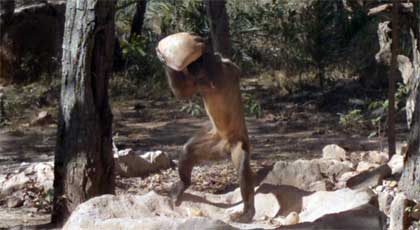 Discovery Channel's previous major co-production with the BBC, 2006's Planet Earth, was a fabulous nature miniseries, presenting astounding visuals and intelligent, illuminating narration in every installment. The networks' newest collaboration, a 10-part series called Life, is just as satisfying... but only in the visual sense...
Discovery Channel's previous major co-production with the BBC, 2006's Planet Earth, was a fabulous nature miniseries, presenting astounding visuals and intelligent, illuminating narration in every installment. The networks' newest collaboration, a 10-part series called Life, is just as satisfying... but only in the visual sense...
Before I complain about what's not as impressive about this new nature miniseries, compared with its predecessor, let me stress what's right about it, and why, even with its flaws, it qualifies as must-see TV.
As with Planet Earth, this new Life serves up set pieces that are amazing on two different, equally impressive levels. You're amazed as the variety, ingenuity and especially the tenacity of these living creatures -- and no less amazed by the ability of the camera crews to photograph them successfully.
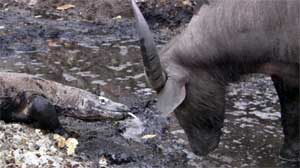
What sorts of things? For starters, there's the familiar old Kimodo dragon -- yet shown here doing something totally unfamiliar, and hunting in a pack to bring down a much larger water buffalo. And there's the capuchin monkeys, seen at top, who have figured out how to use rocks as tools to crack nuts, a process that can take eight years lo learn, but is passed down from generation to generation -- looking a bit like the early scenes in 2001: A Space Odyssey.
There are male humpback whales, following a single female and jockeying for position like Olympic athletes on a speed-skating track. There are tiny Brazilian frogs, making ridiculously long trips up tall trees to protect and feed their tadpoles. And so on, and so on... each image, and each creature, a joy to behold.
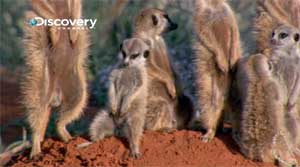
An overview episode, "Challenges of Life," launches the series Sunday night at 8 p.m. ET, on Discovery Channel, Animal Planet and all other Discovery sister networks. The first single-topic episode, "Reptiles and Amphibians," follows at 9 ET, and also is shown on all the affiliated networks. After that, episodes are televised in double helpings on subsequent Sundays, with a can't-miss capper, "Making of Life," closing with a behind-the-scenes look on April 18.
The sequences captured by the wildlife photographers are breathtaking -- some for their dramatic, life-and-death confrontations, others for their sheer intimacy and simplicity. Animal Planet already has made stars of meerkats on the Kalihari in Meerkat Manor, but the "Mammals" episode of Life trumps it a bit by catching a family of meerkats sunning themselves, some of them falling asleep standing up and collapsing backwards.
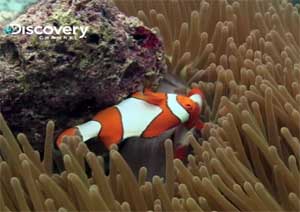
We also get to see clownfish, seemingly straight from Finding Nemo, hiding in the tentacles of a sea anemone that are poisonous to the clownfish's predators, but not to the colorful fish itself. And one of the coolest images in Life is an overhead shot of two humpback whales submerging to procreate -- something that has never been photographed. And still isn't: What we see instead is a calm ocean, and we're left with the poetic realization that beneath that calm surface are mysteries yet unsolved, activities still private.
That moment, in Life, is just right -- but too often, the poetry is missing from this telecast, especially when it's attempted in the narration. Life seems to be presented, except in its visuals, with less subtlety than Planet Earth was. The music is more obvious, the writing more simplistic, and the narration -- at least in this country - less authoritative.
Life is executive produced by Michael Gunton, who was a producer on Sir David Attenborough's excellent The Trials of Life, and is produced by Martha Holmes, one of several producers on another fine nature series, The Blue Planet.
But while Discovery Channel is promoting Life as being from the presenters of Planet Earth, that's misleading. That's true from the network sense, as this, too, is a BBC-Discovery co-production. But the primary producers and directors of Planet Earth, including director Alistair Fothergill and, as writer of many of the episodes, Attenborough, are not contributing to Life in those capacities.
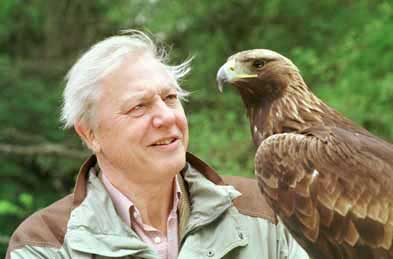
Attenborough, the most authoritative figure in the history of TV nature documentaries, continues to provide his soothing voice to the narration of Life, but only in the British version. Last time, with Planet Earth, Discovery subbed Attenborough's voice with that of Sigourney Weaver. This time, we get Oprah Winfrey. Once again, the best advice is to wait for the DVD version, and make sure it has the original narration.
But it's not only the narrator in Discovery's Life that's irritating. It's the narration, which is so simplistic, it borders on the insulting. The approach has all the sophistication of those old Disney nature films -- fine for the whole family, but the lowest common denominator is much too low. Each episode ends with a summary so tidy and simple that, especially with Winfrey reading it, it sounds like the closing minute of an episode of Desperate Housewives.
For Discovery Channel to think that American audiences would prefer Oprah Winfrey or Sigourney Weaver to Sir David Attenborough is an insult to us all. To "dumb down" the beauty of Life with a grade-school script is an insult to all the filmmakers who toiled to capture those images and animals. And to link Life so directly to Planet Earth, when it's a distant relative at best, is tacky.
All that said, though, Life is beautiful, and you will learn from it, and, at times, you will be amazed. Just don't expect another Planet Earth, or David Attenborough, and you're not likely to be disappointed.